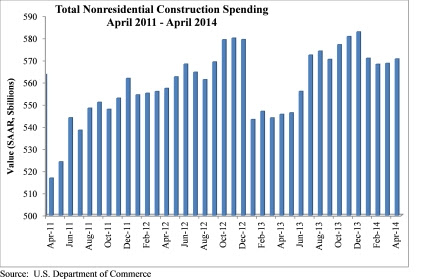Nonresidential construction spending inched up in April according to the June 2 release by the U.S. Census Bureau. This is the second consecutive month spending has increased following March’s upwardly revised spending report.
Nonresidential construction spending expanded by 0.4% on a monthly basis in April and has risen 3.9% on a year-over-year basis. Spending for the month totaled $570.6 billion on a seasonally adjusted, annualized basis.
“Unsurprisingly, nonresidential construction spending has improved with the weather,” said Associated Builders and Contractors Chief Economist Anirban Basu. “As a result of the unusually harsh winter weather, spending declines appeared large during the winter months and subsequent monthly gains have perhaps been a bit exaggerated as well. While the monthly numbers may be skewed, the year-over-year advance of 3.9% seems to realistically capture the rate of improvement in nonresidential construction spending.”
“The U.S. economy has recovered its momentum since the first quarter, suggesting that nonresidential construction’s steady recovery will remain in place,” said Basu. “Indeed, measures of business confidence have improved significantly and there are indications that capital spending is set to accelerate.”
Ten of 16 nonresidential construction subsectors posted increases in spending in April.
• Lodging construction spending is up 1.9% on a monthly basis and is up 16.9% on a year-over-year basis.
• Office-related construction spending grew by 1.7% in April and is up 20% from the same time one year ago.
• Construction spending in the transportation category expanded 3.4% on a monthly basis and has expanded 8% on an annual basis.
• Religious spending grew 1.8% for the month but is down 5.9% from the same time last year.
• Education-related construction spending gained 2.7% for the month and is up 2.9% on a year-over-year basis.
• Commercial construction spending rose 1.2% in April and is up 5.9% on a year-over-year basis.
• Sewage and waste disposal-related construction spending gained 4% for the month but has fallen 5.5% from the same time last year.
• Amusement and recreation-related construction spending expanded 4.4% on a monthly basis and is up 3.2% from the same time last year.
• Health care-related construction spending grew 0.9% for the month, but is down 6.2% on a year-over-year basis.
• Conservation and development-related construction spending expanded by 3.6% for the month and is up 19.7% on an annual basis.
Spending in six nonresidential construction subsectors declined in April.
• Spending in the water supply category fell 0.2% on the month and is down 12.8% from the same time last year.
• Manufacturing-related spending fell 1.1% on a monthly basis, but is up 6.7% on an annual basis.
• Highway and street-related construction spending fell 1.1% in April, but is up 4.8% compared to the same time last year.
• Communication construction spending was down 11.7% for the month but is up 21% from the same time one year ago.
• Public safety-related construction spending fell 0.9% on a monthly basis and has declined 12.4% on a year-over-year basis.
• Power construction spending dipped 1.2% for the month and was 1.6% lower than the same time one year prior.
Related Stories
MFPRO+ News | Jun 3, 2024
Seattle mayor wants to scale back energy code to spur more housing construction
Seattle’s mayor recently proposed that the city scale back a scheduled revamping of its building energy code to help boost housing production. The proposal would halt an update to the city’s multifamily and commercial building energy code that is scheduled to take effect later this year.
Mass Timber | May 31, 2024
Mass timber a big part of Western Washington University’s net-zero ambitions
Western Washington University, in Bellingham, Wash., 90 miles from Seattle, is in the process of expanding its ABET-accredited programs for electrical engineering, computer engineering and science, and energy science. As part of that process, the university is building Kaiser Borsari Hall, the 54,000-sf new home for those academic disciplines that will include teaching labs, research labs, classrooms, collaborative spaces, and administrative offices.
Construction Costs | May 31, 2024
Despite challenges, 2024 construction material prices continue to stabilize
Gordian’s Q2 2024 Quarterly Construction Cost Insights Report indicates that supply chain issues notwithstanding, many commodities are exhibiting price normalization.
University Buildings | May 30, 2024
Washington University School of Medicine opens one of the world’s largest neuroscience research buildings
In St. Louis’ Cortex Innovation District, Washington University School of Medicine recently opened its new Jeffrey T. Fort Neuroscience Research Building. Designed by CannonDesign and Perkins&Will, the 11-story, 609,000-sf facility is one of the largest neuroscience buildings in the world.
Architects | May 30, 2024
AE firm Goodwyn Mills Cawood merges with Southland Engineering
Architecture and engineering firm Goodwyn Mills Cawood (GMC) is further expanding its services through a strategic merger with engineering firm Southland Engineering in Cartersville, Ga.
K-12 Schools | May 30, 2024
Inclusive design strategies to transform learning spaces
Students with disabilities and those experiencing mental health and behavioral conditions represent a group of the most vulnerable students at risk for failing to connect educationally and socially. Educators and school districts are struggling to accommodate all of these nuanced and, at times, overlapping conditions.
MFPRO+ New Projects | May 29, 2024
Two San Francisco multifamily high rises install onsite water recycling systems
Two high-rise apartment buildings in San Francisco have installed onsite water recycling systems that will reuse a total of 3.9 million gallons of wastewater annually. The recycled water will be used for toilet flushing, cooling towers, and landscape irrigation to significantly reduce water usage in both buildings.
Healthcare Facilities | May 28, 2024
Healthcare design: How to improve the parking experience for patients and families
Parking is likely a patient’s—and their families—first and last touch with a healthcare facility. As such, the arrival and departure parking experience can have a profound impact on their experience with the healthcare facility, writes Beth Bryan, PE, PTOE, PTP, STP2, Principal, Project Manager, Walter P Moore.
Urban Planning | May 28, 2024
‘Flowing’ design emphasizes interaction at Bellevue, Wash., development
The three-tower 1,030,000-sf office and retail development designed by Graphite Design Group in collaboration with Compton Design Office for Vulcan Real Estate is attracting some of the world’s largest names in tech and hospitality.
MFPRO+ News | May 28, 2024
ENERGY STAR NextGen Certification for New Homes and Apartments launched
The U.S. Environmental Protection Agency recently launched ENERGY STAR NextGen Certified Homes and Apartments, a voluntary certification program for new residential buildings. The program will increase national energy and emissions savings by accelerating the building industry’s adoption of advanced, energy-efficient technologies, according to an EPA news release.


















